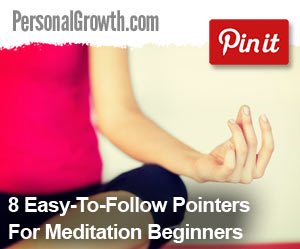

If you’ve only heard or read about meditation from people who are experienced, long-term practitioners, then you might understandably find the concept to be overwhelming and complicated.
Perhaps you like the idea of using meditation techniques to clear your mind and feel more centered in your life, but you automatically think “I could never do that,” because it seems difficult. The truth is, getting started with meditating is easier than you may realize, provided you are patient, willing to learn and dedicated to the principles behind the practice.
Use the eight pointers detailed below as an introductory guide to meditation and you will find that you can indeed meet this achievement.
1. Don’t Get Discouraged, Practice Makes Perfect
Training your mind to the point where you can observe and be fully aware of your thoughts without assigning emotion or judgment to them is an ongoing process.
Accept that you are likely to find yourself distracted by one or several thoughts as you first start meditating. Strive to improve with practice rather than become frustrated and discouraged.
2. Make Meditation A Part Of Your Everyday Routine
When you integrate a habit into your consistent daily routine, you are much more likely to not only maintain the practice but also become more confident in reaching your goals.
Dedicate a portion of each day to meditating, choosing a time during which you are most alert and least prone to being distracted by household or job tasks.
3. Find A Comfortable Posture
Many people enjoy meditating in a lotus (seated with legs crossed) position. Try the lotus position while sitting on the floor, on a chair or on another piece of furniture and choose the area that you find most comfortable and most conducive to focusing.
You are not limited to the lotus position, so if you prefer, try alternative postures such as sitting with your legs straight out, lying flat or standing.
4. Focus On Breathing Exercises
Breath control and awareness is a basic element of meditation as it provides you with a centering mechanism. Start out by breathing deeply through your nose for four counts, then exhaling your breath through your nose for another four counts.
Repeat this process as you meditate. If you need help concentrating on your breathing patterns, try counting to yourself or mentally repeating the phrase “Breathe in, breathe out.”
5. Try Some Basic Mindfulness Meditation Techniques
Simplify the process of mindfulness meditation, in which you acknowledge your thoughts without allowing your mental focus to dwell upon them, by assigning one word to each thought as it occurs.
For example, mentally categorize your thoughts with phrases such as “worry,” “happy” or “sad.” Once you have internally observed the thought, let it drift away while maintaining focus on your breathing.
6. If Complete Quiet Bothers You, Consider Listening Meditation
You do not necessarily have to meditate in a completely quiet area in order to be successful. If your mental function is stronger in general when background noise is present, then meditate to the sounds of music, nature, running water or recorded chants.
This type of meditation, “listening meditation,” can also be practiced in public settings once you gain experience.
7. Use An Object As A Focus Point
Some people are best able to meditate when they have an object or mental image on which to focus during the practice. If you are meditating with your eyes open, choose a focal point in the room and keep your concentration on that point as you avoid dwelling on thoughts.
If you prefer to have your eyes closed, then allow a picture of your focal point to stay central in your mind.

8. Keep A Journal Of Your Progress
After each meditation session, write down the details of your overall experience, areas in which you feel confident and areas in which you would like to improve in subsequent sessions.
Review the journal record of your progress periodically, and before long, you will realize that meditating is not as daunting as you once may have thought.

